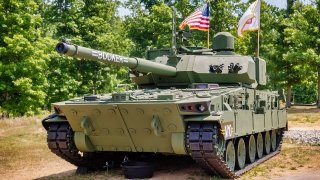These 3 Powerful U.S. Army Vehicles Are Preparing America's Next Big War
In 2023, the Army introduced 24 new systems, with expectations for similar progress in 2024. Key developments include the M10 Booker, an infantry-support armored vehicle boasting a 105mm main gun and other heavy armaments, and the XM30 Mechanized Infantry Fighting Vehicle, set to replace the aging M2 Bradley with enhanced lethality and survivability.
Summary: The U.S. Army is undergoing a significant modernization to adapt to the evolving nature of warfare, focusing on large-scale conventional battles against formidable adversaries like China and Russia. This shift marks a departure from two decades of counterinsurgency operations. In 2023, the Army introduced 24 new systems, with expectations for similar progress in 2024. Key developments include the M10 Booker, an infantry-support armored vehicle boasting a 105mm main gun and other heavy armaments, and the XM30 Mechanized Infantry Fighting Vehicle, set to replace the aging M2 Bradley with enhanced lethality and survivability. Additionally, the Army is exploring unmanned capabilities with the Robotic Combat Vehicle, aiming for increased situational awareness and tactical options. These initiatives reflect the Army's commitment to staying ahead in a rapidly changing battlefield landscape.
The Future of U.S. Army Warfare: Introducing the M10 Booker and XM30 Vehicle
The Army is modernizing. More than 20 years of combat in the Middle East against terrorist groups and insurgencies forced the military into a particular mindset under which unconventional threats, such as improvised explosive devices (IEDs), were on top of the threat list. However, times have changed, and large-scale conventional warfare with near-peer adversaries like China and Russia is back on the menu.
Therefore, the Army is upgrading its arsenal to meet the challenges of the future. In 2023, the Army received 24 new systems as part of this modernization process. This year is expected to be similarly productive. When it comes to ground combat systems, there are three platforms to keep an eye out for in 2024.
THE M10 BOOKER
The M10 Booker is an infantry-support armored vehicle designed to pave the way for mechanized infantry with its firepower and mobility.
The M10 Booker packs quite a punch. The armored vehicle is equipped with a 105mm M35 main gun, an M2 Browning 12.7mm heavy machine gun, and a 7.62mm light machine gun; it also sports several sensors for urban fighting. The M10 Booker’s heavy weaponry can even take out light enemy armored vehicles (or even a tank with a well-placed shot in a vulnerable spot).
With a weight of approximately 40 tons, the M10 Booker can hit a maximum speed of 45 miles per hour and operate up to 350 miles without any refueling. In terms of compliment, the Army stuck with the four-man crew with its newest armored vehicle. Moreover, the new combat vehicle comes with a modular design that can incorporate new technology as it develops.
The M10 Booker will bring an added level of lethality and protection to its mechanized combat teams, the Army said. Fast tempo is everything in warfare as the Army knows very well from its large-scale fighting against Iraqi forces during the initial stages of Operation Iraqi Freedom: In less than a month, the Army and Marine Corps reached Baghdad and prompted the fall of Iraqi dictator Saddam Hussein and his Baathist regime. The fighting in Ukraine has only reiterated that speed can make or break a large-scale offensive operation. The vehicle will allow the Army to remain speedy on the battlefields of the future.
The M10 Booker is named after Private Robert D. Booker, who was posthumously awarded the Medal of Honor during World War II, and Staff Sergeant Stevon A. Booker, who was posthumously awarded the Distinguished Service Cross for his actions in the opening days of Operation Iraqi Freedom.
The Army has a contract with General Dynamics Land Systems for 26 combat vehicles with the option to buy another 70 as part of the initial production phase.
Related: Lighten the load: The Army’s plan to save time by shedding excess gear
THE XM30 MECHANIZED INFANTRY FIGHTING VEHICLE
The next ground system to keep an eye out for is the XM30 Mechanized Infantry Fighting Vehicle. Still under development, the XM30 is the replacement of the venerable M2 Bradley, which has been in service for more than 40 years.
The M2 Bradley is proving itself extremely useful in the fighting in Ukraine, showcasing the importance of infantry fighting vehicles in modern combat.
“The XM30 will replace the Bradley fighting vehicle, bringing new transformational capabilities to the fight; these will include improvements to lethality, Soldier-vehicle survivability, and upgradeability beyond the physical and economic limits of the Bradley,” Assistant Secretary of the Army for Acquisition, Logistics and Technology Douglas R. Bush said in June.
When it comes to weaponry, the XM30 will likely have a main gun, a light machine gun, and anti-tank missiles. For the prototypes, the Army has requested a 50mm main gun on a remote turret and anti-tank missiles. The key feature requirements have also specified a crew of two and room for six fully equipped infantrymen.
Similar to the M10 Booker, and many other new weapon systems, the XM30 will come in a modular design that will allow the Army to incorporate novel technology as it becomes available.
“The modular open system architecture of the XM30 will allow new building technology to be added to the vehicle as that technology matures, ensuring an overwhelming advantage in any potential adversary competition,” Bush added.
Last year, the Army chose American Rheinmetall Vehicles and General Dynamics Land Systems as the finalists out of five contenders. The two companies now have a $1.6 billion contract to deliver their prototypes by the end of 2024. As far as operational capability, the Army wants to have something before the end of the decade.
Related: 3D printers could print the future face of war
ROBOTIC COMBAT VEHICLE
The Robotic Combat Vehicle will be an unmanned ground system. The modular and lightweight vehicle will offer fire support and reconnaissance capabilities.
“The RCV-Light will deliver increased situational awareness, lethality, and tactical options for Army formations in support of multi-domain operations. Its operators will remotely control RCVs or task them to operate semi-autonomously. Variants will serve as ‘scouts’ or ‘escorts’ for manned fighting vehicles,” the Army said last year.
The Robotic Combat Vehicle is still under development. In September 2023, the Army awarded four companies contracts to design a prototype by August 2024. The service is looking for an operational capability before the end of the decade.
In addition to its combat systems, the Robotic Combat Vehicle will require robust electronic warfare capabilities to ensure it can operate in a permissive electronic warfare environment.
Unmanned systems aren’t just the future of warfare, they are already playing a big part in it as combat footage from Ukraine – where both sides are using drones by the hundreds daily – shows.
About the Author
Stavros Atlamazoglou is a seasoned defense journalist specializing in special operations and national security. He is a Hellenic Army veteran (national service with the 575th Marine Battalion and Army HQ). He holds a BA from the Johns Hopkins University, an MA from the Johns Hopkins’ School of Advanced International Studies (SAIS), and is pursuing a J.D. at Boston College Law School.
This article was first published by Sandboxx News.


